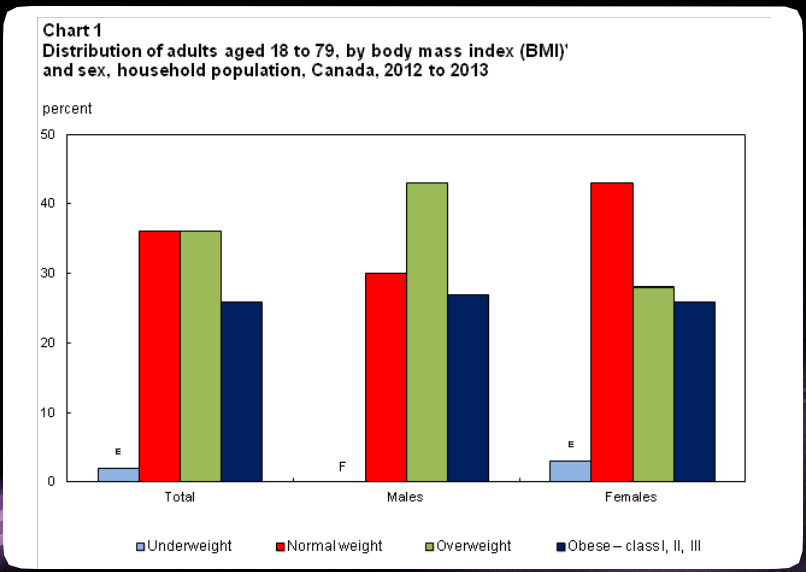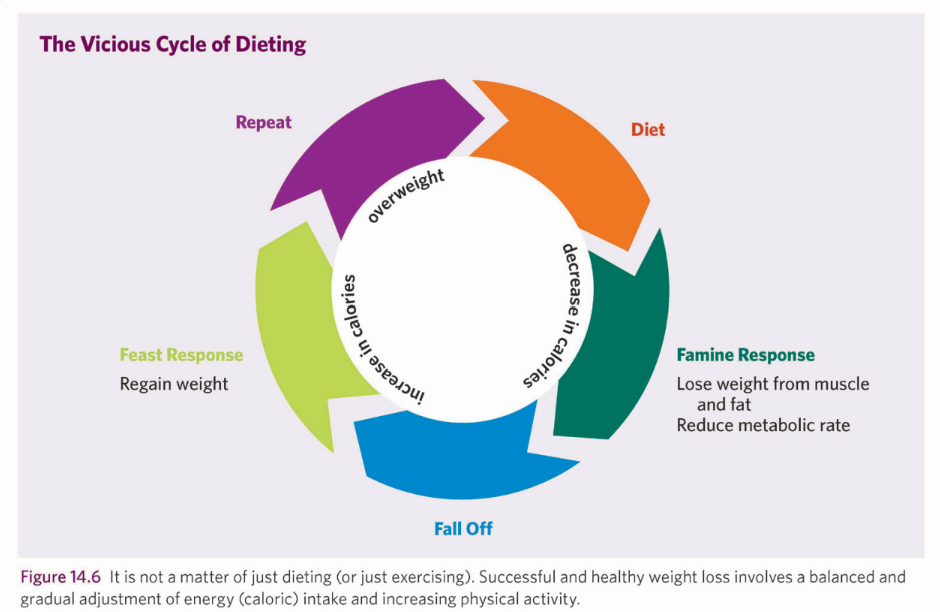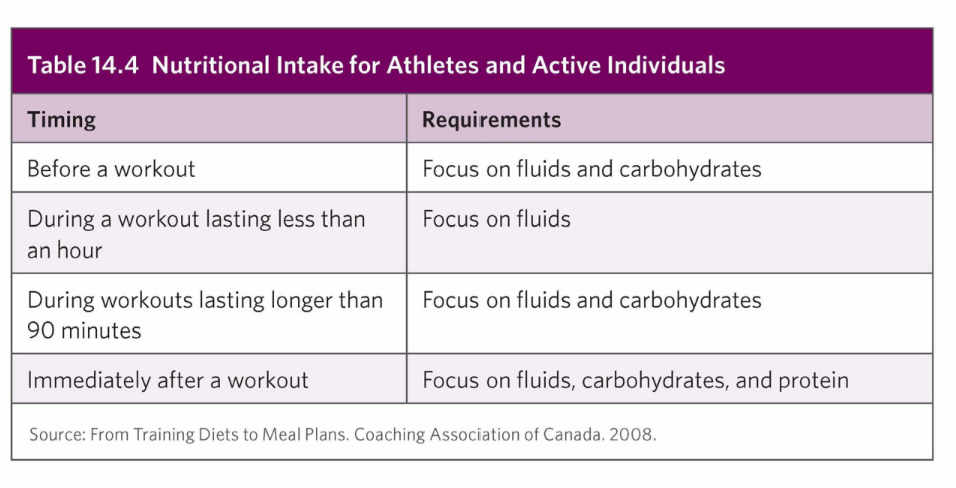
14.4 - Nutrition For Performance
Body Mass Index (BMI)
BMI is widely used to assess the extent to which individuals are underweight or overweight.
It is calculated as the ratio of a person’s weight to the square of his or her height:
BMI = Weight (Kg) / Height (M²)
Generally:
People with a BMI of 25 to 30 are considered to be overweight.
Those with a BMI score of 30 or more are considered obese.
Individuals with a BMI of 18.5 or lower are considered to be underweight.
What’s Flawed About the BMI Index?
BMI is used worldwide to estimate body weight and to make comparisons across population groups.
The main reason for this widespread use is that BMI is easy to measure and to compute.
However, BMI does not distinguish between muscle mass and fat.
Athletic individuals who may have heavy muscle mass could have a BMI indicating that they are obese.
BMI is also not adjusted across population groups.
Factors such as age and gender can make a big difference.
Nevertheless, keep in mind that BMI is normally the calculation used around the world and in Canada in relation to body weight comparisons.
The Effects of Exercise on Fat Loss and Muscle Gain
For most people, excess body weight impairs the performance of physical activity.
However, rapid and extreme weight loss can have many detrimental consequences.
Total energy intake combined with energy expenditure are the most important things to consider in adjusting one’s body weight.
A gradual weight loss program ensures maximum fat loss along with the preservation of lean muscle tissue.
Should Being Underweight Be A Cause for Concern?
The high value that North American society places on thinness may explain why being “underweight” (defined as a BMI of less than 18.5) is not generally seen as a health risk comparable to being overweight or obese.
Nevertheless, for some people, being underweight can definitely be a serious health concern.

Is There An “Internal” Control Mechanism?
Set-point theory suggests that individuals who are dieting become more obsessed with food as their body tries to regain its “set-point.”
Therefore, the theory maintains, dieting can be pointless and frustrating.
Whether you support this theory or not, it actually underlines the importance of a combined approach to altering body weight through limiting caloric intake and increasing physical activity.
Exercise, some experts believe, contributes to a lower “set-point” level.
Exercise also increases the amount of muscle mass, which increases RMR.
The Vicious Cycle of Dieting

Energy Imbalance and Female Athletes
Failure to supply the body with enough overall calories for daily activities, especially if combined with exercise, creates a negative “energy drain.”
Female athletes in particular need to pay special attention to nutrition as well as overall energy intake in their diets.
For female athletes, energy imbalances can lead to a number of serious health conditions.
One of these conditions is known as the female athlete triad.
The Female Athlete Triad
The female athlete triad has three components:
1. low energy availability
2. menstrual irregularities
3. low bone mass
Athletes suffering from this triad may experience problems in any one of these three areas, but all are related to not taking in enough calories in their diets.
Female athletes who do not consume enough calories to match their activity levels invariably jeopardize both their performance and their health.
Nutrition Needs of Vegetarian Athletes
A well-balanced vegetarian diet can support an active lifestyle.
Vegetarian diets tend to be high in carbohydrates and low in fat, which naturally complements the dietary goals related to optimal sport performance.
However, like other athletes, vegetarian athletes need to monitor their vitamin and mineral intake and their energy needs.
Timing of Nutritional Intake for Athletes
The timing of nutritional intake is very important.
Pre-exercise nutrition
Ideally, this meal will be relatively high in complex carbohydrates and low in both fat and fibre. The portion should be small to moderate in size.
During-exercise nutrition
Maintenance of hydration is one of the main goals of an athlete during competition and training.
Post-exercise nutrition
The nutrition goals of this period are to rehydrate, refuel, and help promote adaptations.
Before, During, and After Exercise
Athletes and active individuals need to ensure balanced meals and snacks.

The Risks of Dehydration
Excessive fluid loss (dehydration) can lead to a number of dangerous conditions:
Muscle cramps: The symptoms include painful muscle twitches, followed by total muscle cramps.
Heat exhaustion: Symptoms of this dangerous condition include a high body temperature; pale, cool, and clammy skin; light-headedness; and possibly loss of consciousness.
Heat stroke: A life-threatening condition that occurs when there is a complete failure of the body’s heat-regulatory system.
Symptoms:
Very high body temperature
Headache
Confusion or behavioural change
Possibly a loss of consciousness
14.4 - Nutrition For Performance
Body Mass Index (BMI)
BMI is widely used to assess the extent to which individuals are underweight or overweight.
It is calculated as the ratio of a person’s weight to the square of his or her height:
BMI = Weight (Kg) / Height (M²)
Generally:
People with a BMI of 25 to 30 are considered to be overweight.
Those with a BMI score of 30 or more are considered obese.
Individuals with a BMI of 18.5 or lower are considered to be underweight.
What’s Flawed About the BMI Index?
BMI is used worldwide to estimate body weight and to make comparisons across population groups.
The main reason for this widespread use is that BMI is easy to measure and to compute.
However, BMI does not distinguish between muscle mass and fat.
Athletic individuals who may have heavy muscle mass could have a BMI indicating that they are obese.
BMI is also not adjusted across population groups.
Factors such as age and gender can make a big difference.
Nevertheless, keep in mind that BMI is normally the calculation used around the world and in Canada in relation to body weight comparisons.
The Effects of Exercise on Fat Loss and Muscle Gain
For most people, excess body weight impairs the performance of physical activity.
However, rapid and extreme weight loss can have many detrimental consequences.
Total energy intake combined with energy expenditure are the most important things to consider in adjusting one’s body weight.
A gradual weight loss program ensures maximum fat loss along with the preservation of lean muscle tissue.
Should Being Underweight Be A Cause for Concern?
The high value that North American society places on thinness may explain why being “underweight” (defined as a BMI of less than 18.5) is not generally seen as a health risk comparable to being overweight or obese.
Nevertheless, for some people, being underweight can definitely be a serious health concern.

Is There An “Internal” Control Mechanism?
Set-point theory suggests that individuals who are dieting become more obsessed with food as their body tries to regain its “set-point.”
Therefore, the theory maintains, dieting can be pointless and frustrating.
Whether you support this theory or not, it actually underlines the importance of a combined approach to altering body weight through limiting caloric intake and increasing physical activity.
Exercise, some experts believe, contributes to a lower “set-point” level.
Exercise also increases the amount of muscle mass, which increases RMR.
The Vicious Cycle of Dieting

Energy Imbalance and Female Athletes
Failure to supply the body with enough overall calories for daily activities, especially if combined with exercise, creates a negative “energy drain.”
Female athletes in particular need to pay special attention to nutrition as well as overall energy intake in their diets.
For female athletes, energy imbalances can lead to a number of serious health conditions.
One of these conditions is known as the female athlete triad.
The Female Athlete Triad
The female athlete triad has three components:
1. low energy availability
2. menstrual irregularities
3. low bone mass
Athletes suffering from this triad may experience problems in any one of these three areas, but all are related to not taking in enough calories in their diets.
Female athletes who do not consume enough calories to match their activity levels invariably jeopardize both their performance and their health.
Nutrition Needs of Vegetarian Athletes
A well-balanced vegetarian diet can support an active lifestyle.
Vegetarian diets tend to be high in carbohydrates and low in fat, which naturally complements the dietary goals related to optimal sport performance.
However, like other athletes, vegetarian athletes need to monitor their vitamin and mineral intake and their energy needs.
Timing of Nutritional Intake for Athletes
The timing of nutritional intake is very important.
Pre-exercise nutrition
Ideally, this meal will be relatively high in complex carbohydrates and low in both fat and fibre. The portion should be small to moderate in size.
During-exercise nutrition
Maintenance of hydration is one of the main goals of an athlete during competition and training.
Post-exercise nutrition
The nutrition goals of this period are to rehydrate, refuel, and help promote adaptations.
Before, During, and After Exercise
Athletes and active individuals need to ensure balanced meals and snacks.

The Risks of Dehydration
Excessive fluid loss (dehydration) can lead to a number of dangerous conditions:
Muscle cramps: The symptoms include painful muscle twitches, followed by total muscle cramps.
Heat exhaustion: Symptoms of this dangerous condition include a high body temperature; pale, cool, and clammy skin; light-headedness; and possibly loss of consciousness.
Heat stroke: A life-threatening condition that occurs when there is a complete failure of the body’s heat-regulatory system.
Symptoms:
Very high body temperature
Headache
Confusion or behavioural change
Possibly a loss of consciousness